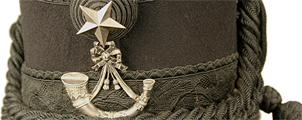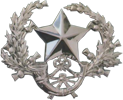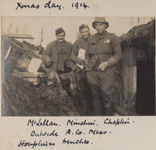Christmas in the trenches with The Cameronians (Scottish Rifles)
As we commemorate the 100 year centenary of the First World War the collections team here at South Lanarkshire Leisure and Culture have been sorting through all the objects and archive we have relating to the First World War. During this process we have come across a number of poignant and interesting objects relating to Christmas in the trenches.
For most soldiers Christmas Day in a theatre of war would be like any other day perhaps with the added bonus of a few extra cigarettes or cakes to share amongst them. December 1914 in France also saw very cold, wet and muddy conditions so men would have struggled to stay dry and warm for long. These photographs from the museum collection show officers of the 1st and 5th Battalions in the trenches on Christmas Day 1914 with Captain T. R. McLellan playing the bagpipes for the men and Private Coghlan doing his best to cheer up the men by dressing up.
There has been much mention recently of the Christmas Truce of 1914, when soldiers of the British Army and German Armies observed a truce for Christmas Day and met in no-man’s land to exchange gifts and play football. The truce was not observed everywhere along the Western Front and fighting continued in many places. Extracts from the war diaries, which have been fully transcribed by our volunteers, The Friends of Low Parks Museum, show that of the three battalions of The Cameronians who were out in France by December 1914, the 1st and 2nd Battalions carried on as normal. The 1st Battalion reported: “Enemy very noisy during night. One man wounded.” The 5th Battalion however reported: “Very little sniping, almost an understanding not to fire but one man killed by a sniper”. The 5th Battalion History book elaborates on this saying:
“On Christmas Eve we could hear the Germans (XIXth Saxon Corps) celebrating the advent of Christmas by singing and merrymaking. We could also hear a brass band behind the houses in their lines playing Christmas carols. For roughly twenty-four hours, Christmas Eve to late afternoon on Christmas day, they ceased firing at us, and we reciprocated. An attempt at fraternisation took place on Christmas day, ” Jerry ” leaving his trench unarmed. Certain souvenirs were exchanged and, if it had been left to the soldiery of both sides, the war would there and then have been declared a draw. But towards late afternoon on Christmas day a stray shot from our right front hit one of ours, No. 6 I 79, Corpl. W. S. Smith, No. 2 Company (from which he died next day). The Saxons opposite us were at pains to let us know that it was a Prussian who had fired the shot which killed Smith. This broke the spell, however, and the war was resumed after a tacit truce of twenty four hours. This truce drew forth an army routine order reminding us that we ‘were in France to fight and not to fraternise with the enemy.”
Christmas could be a lonely time for soldiers when thoughts would turn to loved ones at home. Friends and families would send letters and parcels to the men at the front and often soldiers would send embroidered postcards like the one below to their beloved.
We recently came across the postcard below in the collection. Writing home to the daughter he has yet to meet, Rifleman Davidson wishes her a “merry merry Christmas…and a merrier and prosperous New Year.” Unfortunately we have been unable to track down exactly who Rfn Davidson was and if he did indeed survive to meet his new daughter. If you have any information which could help us with this then please do let us know.
Comments: 0









Leave a Reply